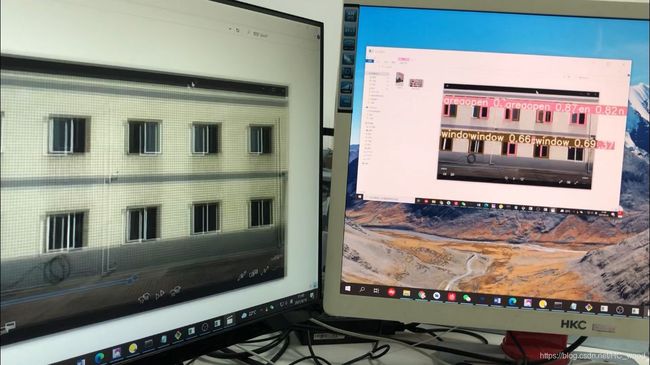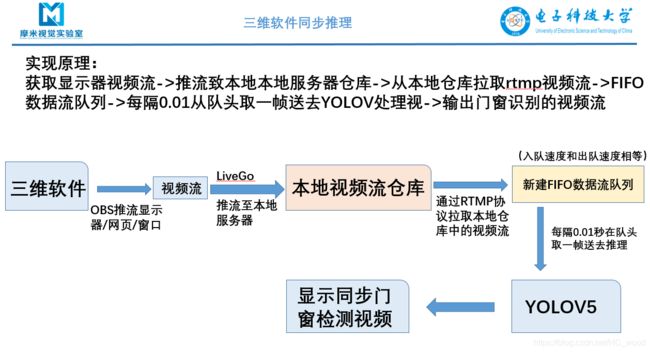将yolov5的detect.py改写成可以供其他程序调用的方式,并实现低时延(<0.5s)直播推理
将yolov5的推理代码改成可供其它程序调用的方式,并实现低时延(<0.5s)直播推理
yolov5的代码具有高度的模块化,对于初学者十分友好,但是如果咱们要做二次开发,想直接调用其中一些函数,恐怕还是得费一番功夫。
参考https://www.pythonheidong.com/blog/article/851830/44a42d351037d307d02d/
和https://blog.csdn.net/ld_long/article/details/113920521(不知道为什么失效了)
实现了:
t=detectapi(weights)
results,names=t.detect(source)
其中参数 weights是权重文件的路径。参数source是一个列表,列表的每个元素是由cv2的读取的图片。返回值results是一个列表。列表的元素个数为source的元素个数,每个元素为每张图片的处理结果。每张图片的处理结果有两个,一个是一张在原图片中画框标识物品的cv2图片。另一个是一个列表,这个列表的元素个数等于本图片探测到的物品数量。元素为这个物品的信息:(物品在names中的引索,[物品的位置x1,y1,x2,y2],置信度)。返回值names为物品字典。
应用如下:打开摄像头,实时探测目标物品
import cv2
import detect
cap=cv2.VideoCapture(0)
a=detect.detectapi(weights='weights/yolov5s.pt')
while True:
rec,img = cap.read()
result,names =a.detect([img])
img=result[0][0] #第一张图片的处理结果图片
'''
for cls,(x1,y1,x2,y2),conf in result[0][1]: #第一张图片的处理结果标签。
print(cls,x1,y1,x2,y2,conf)
cv2.rectangle(img,(x1,y1),(x2,y2),(0,255,0))
cv2.putText(img,names[cls],(x1,y1-20),cv2.FONT_HERSHEY_DUPLEX,1.5,(255,0,0))
'''
cv2.imshow("vedio",img)
if cv2.waitKey(1)==ord('q'):
break
下面将detect.py做如下新增,原来的代码不要删
# 增加运行参数,原来的参数是通过命令行解析对象提供的,这里改为由调用者在代码中提供。需要一个
# 大体上完成一样功能的参数对象。
# 我想要的功能是传一组由cv2读取的图片,交给api,然后得到一组打上标签的图片,以及每张图片对应的标签类别引索,位置信息,置信度的信息,还有类别名称字典
# 要实现这个功能,需要权重文件,输入文件两个参数,其他参数与原代码命令行默认参数保持一致就行。
class simulation_opt:# 参数对象。
def __init__(self,weights,img_size=640,conf_thres=0.25,iou_thres=0.45,device='',view_img=False,
classes=None,agnostic_nms=False,augment=False,update=False,exist_ok=False):
self.weights=weights
self.source=None
self.img_size=img_size
self.conf_thres=conf_thres
self.iou_thres=iou_thres
self.device=device
self.view_img=view_img
self.classes=classes
self.agnostic_nms=agnostic_nms
self.augment=augment
self.update=update
self.exist_ok=exist_ok
#增加一个新类,这个新类是在原来detect函数上进行删减。可以先复制原来的detect函数代码,再着手修改
class detectapi:
def __init__(self,weights,img_size=640):
# 构造函数中先做好必要的准备,如初始化参数,加载模型
''' 删掉
source, weights, view_img, save_txt, imgsz = opt.source, opt.weights, opt.view_img, opt.save_txt, opt.img_size
webcam = source.isnumeric() or source.endswith('.txt') or source.lower().startswith(
('rtsp://', 'rtmp://', 'http://'))
''' #改为
self.opt=simulation_opt(weights=weights,img_size=img_size)
weights, imgsz= self.opt.weights, self.opt.img_size
''' 删掉
# Directories
#save_dir = Path(increment_path(Path(opt.project) / opt.name, exist_ok=opt.exist_ok)) # increment run
#(save_dir / 'labels' if save_txt else save_dir).mkdir(parents=True, exist_ok=True) # make dir
'''
# Initialize
set_logging()
self.device = select_device(self.opt.device)
self.half = self.device.type != 'cpu' # half precision only supported on CUDA
# Load model
self.model = attempt_load(weights, map_location=self.device) # load FP32 model
self.stride = int(self.model.stride.max()) # model stride
self.imgsz = check_img_size(imgsz, s=self.stride) # check img_size
if self.half:
self.model.half() # to FP16
# Second-stage classifier
self.classify = False
if self.classify:
self.modelc = load_classifier(name='resnet101', n=2) # initialize
self.modelc.load_state_dict(torch.load('weights/resnet101.pt', map_location=self.device)['model']).to(self.device).eval()
'''
self.names,和self.colors是由后面的代码拉到这里来的。names是类别名称字典,colors是画框时用到的颜色。
'''
# read names and colors
self.names = self.model.module.names if hasattr(self.model, 'module') else self.model.names
self.colors = [[random.randint(0, 255) for _ in range(3)] for _ in self.names]
def detect(self,source): # 使用时,调用这个函数
if type(source)!=list:
raise TypeError('source must be a list which contain pictures read by cv2')
'''删掉
if webcam:
view_img = check_imshow()
cudnn.benchmark = True # set True to speed up constant image size inference
dataset = LoadStreams(source, img_size=imgsz, stride=stride)
else:
save_img = True
dataset = LoadImages(source, img_size=imgsz, stride=stride)
'''# 改为
# Set Dataloader
dataset = MyLoadImages(source, img_size=self.imgsz, stride=self.stride)
# 原来是通过路径加载数据集的,现在source里面就是加载好的图片,所以数据集对象的实现要
# 重写。修改代码后附。在utils.dataset.py上修改。
'''移动到构造方法末尾。names是类别名称字典,colors是画框时用到的颜色。
names = model.module.names if hasattr(model, 'module') else model.names
colors = [[random.randint(0, 255) for _ in range(3)] for _ in names]
'''
# Run inference
if self.device.type != 'cpu':
self.model(torch.zeros(1, 3, self.imgsz, self.imgsz).to(self.device).type_as(next(self.model.parameters()))) # run once
result=[]
''' 删掉
for path, img, im0s, vid_cap in dataset: 因为不用保存,所以path可以不要,因为不处理视频,所以vid_cap不要。
''' #改为
for img, im0s in dataset:
img = torch.from_numpy(img).to(self.device)
img = img.half() if self.half else img.float() # uint8 to fp16/32
img /= 255.0 # 0 - 255 to 0.0 - 1.0
if img.ndimension() == 3:
img = img.unsqueeze(0)
# Inference
# t1 = time_synchronized() #计算预测用时的,可以不要
pred = self.model(img, augment=self.opt.augment)[0]
# Apply NMS
pred = non_max_suppression(pred, self.opt.conf_thres, self.opt.iou_thres, classes=self.opt.classes, agnostic=self.opt.agnostic_nms)
# t2 = time_synchronized() #计算预测用时的,可以不要
# Apply Classifier
if self.classify:
pred = apply_classifier(pred, self.modelc, img, im0s)
'''删掉
for i, det in enumerate(pred): # detections per image
if webcam: # batch_size >= 1
p, s, im0, frame = path[i], '%g: ' % i, im0s[i].copy(), dataset.count
else:
p, s, im0, frame = path, '', im0s, getattr(dataset, 'frame', 0)
p = Path(p) # to Path
save_path = str(save_dir / p.name) # img.jpg
txt_path = str(save_dir / 'labels' / p.stem) + ('' if dataset.mode == 'image' else f'_{frame}') # img.txt
s += '%gx%g ' % img.shape[2:] # print string
gn = torch.tensor(im0.shape)[[1, 0, 1, 0]] # normalization gain whwh
if len(det):
# Rescale boxes from img_size to im0 size
det[:, :4] = scale_coords(img.shape[2:], det[:, :4], im0.shape).round()
# Print results
for c in det[:, -1].unique():
n = (det[:, -1] == c).sum() # detections per class
s += f"{n} {names[int(c)]}{'s' * (n > 1)}, " # add to string
# Write results
for *xyxy, conf, cls in reversed(det):
if save_txt: # Write to file
xywh = (xyxy2xywh(torch.tensor(xyxy).view(1, 4)) / gn).view(-1).tolist() # normalized xywh
line = (cls, *xywh, conf) if opt.save_conf else (cls, *xywh) # label format
with open(txt_path + '.txt', 'a') as f:
f.write(('%g ' * len(line)).rstrip() % line + '\n')
if save_img or view_img: # Add bbox to image
label = f'{names[int(cls)]} {conf:.2f}'
plot_one_box(xyxy, im0, label=label, color=colors[int(cls)], line_thickness=3)
''' # 改为
# Process detections
det=pred[0] #原来的情况是要保持图片,因此多了很多关于保持路径上的处理。另外,pred
# 其实是个列表。元素个数为batch_size。由于对于我这个api,每次只处理一个图片,
# 所以pred中只有一个元素,直接取出来就行,不用for循环。
im0 = im0s.copy() # 这是原图片,与被传进来的图片是同地址的,需要copy一个副本,否则,原来的图片会受到影响
# s += '%gx%g ' % img.shape[2:] # print string
# gn = torch.tensor(im0.shape)[[1, 0, 1, 0]] # normalization gain whwh
result_txt = []
# 对于一张图片,可能有多个可被检测的目标。所以结果标签也可能有多个。
# 每被检测出一个物体,result_txt的长度就加一。result_txt中的每个元素是个列表,记录着
# 被检测物的类别引索,在图片上的位置,以及置信度
if len(det):
# Rescale boxes from img_size to im0 size
det[:, :4] = scale_coords(img.shape[2:], det[:, :4], im0.shape).round()
# Print results
'''
for c in det[:, -1].unique():
n = (det[:, -1] == c).sum() # detections per class
s += f"{n} {self.names[int(c)]}{'s' * (n > 1)}, " # add to string
'''
# Write results
for *xyxy, conf, cls in reversed(det):
#xywh = (xyxy2xywh(torch.tensor(xyxy).view(1, 4)) / gn).view(-1).tolist() # normalized xywh
line = (int(cls.item()), [int(_.item()) for _ in xyxy], conf.item()) # label format
result_txt.append(line)
label = f'{self.names[int(cls)]} {conf:.2f}'
plot_one_box(xyxy, im0, label=label, color=self.colors[int(cls)], line_thickness=3)
result.append((im0,result_txt)) # 对于每张图片,返回画完框的图片,以及该图片的标签列表。
return result, self.names
下面对 yolov5/utils/dataset.py 修改,直接把下面代码增加到dataset.py即可,其他代码不用动。
class MyLoadImages: # for inference
def __init__(self, path, img_size=640, stride=32):
for img in path:
if type(img)!=np.ndarray or len(img.shape)!=3:
raise TypeError('there is a object which is not a picture read by cv2 in source')
'''
p = str(Path(path).absolute()) # os-agnostic absolute path
if '*' in p:
files = sorted(glob.glob(p, recursive=True)) # glob
elif os.path.isdir(p):
files = sorted(glob.glob(os.path.join(p, '*.*'))) # dir
elif os.path.isfile(p):
files = [p] # files
else:
raise Exception(f'ERROR: {p} does not exist')
images = [x for x in files if x.split('.')[-1].lower() in img_formats]
videos = [x for x in files if x.split('.')[-1].lower() in vid_formats]
ni, nv = len(images), len(videos)
'''
self.img_size = img_size
self.stride = stride
self.files = path
self.nf = len(path)
#self.video_flag = [False] * ni + [True] * nv
self.mode = 'image'
#if any(videos):
#self.new_video(videos[0]) # new video
#else:
#self.cap = None
#assert self.nf > 0, f'No images or videos found in {p}. ' \
#f'Supported formats are:\nimages: {img_formats}\nvideos: {vid_formats}'
def __iter__(self):
self.count = 0
return self
def __next__(self):
if self.count == self.nf:
raise StopIteration
path = self.files[self.count]
'''
if self.video_flag[self.count]:
# Read video
self.mode = 'video'
ret_val, img0 = self.cap.read()
if not ret_val:
self.count += 1
self.cap.release()
if self.count == self.nf: # last video
raise StopIteration
else:
path = self.files[self.count]
self.new_video(path)
ret_val, img0 = self.cap.read()
self.frame += 1
print(f'video {self.count + 1}/{self.nf} ({self.frame}/{self.nframes}) {path}: ', end='')
'''
# Read image
self.count += 1
#img0 = cv2.imread(path) # BGR
#assert img0 is not None, 'Image Not Found ' + path
#print(f'image {self.count}/{self.nf} {path}: ', end='')
# Padded resize
img = letterbox(path, self.img_size, stride=self.stride)[0]
# Convert
img = img[:, :, ::-1].transpose(2, 0, 1) # BGR to RGB, to 3x416x416
img = np.ascontiguousarray(img)
return img, path
效果如下:
在实际的使用中,我并没有用摄像头,而是通过rtmp拉取视频流的方式读取的数据,会有10秒推理延迟,为解决这个问题,我新建了缓存队列,将读取到的数据存入队列中,保证入队和出队速度相同(相当于一个滑动窗口),yolov5每隔0.01秒在队头取一帧用来推理。从而防止出现动态延迟。
代码如下:
新建demo.py,把刚刚加了代码的detect.py导入进来
import cv2
import multiprocessing as mp
import detect
import time
def image_put(q, ip, port, name):
cap = cv2.VideoCapture("rtmp://localhost:1935/live/movie")
if cap.isOpened():
print(name)
while True:
q.put(cap.read()[1])
q.get() if q.qsize() > 1 else time.sleep(0.01)
#print("555" * 25) if cap.read()[0] == False else print(" ")
def get_frames():
camera_ip, camera_port, camera_name = "192.168.2.119", "554", "stream0"
mp.set_start_method(method='spawn') # init
queue = mp.Queue(maxsize=2)
processes = mp.Process(target=image_put, args=(queue, camera_ip, camera_port, camera_name)),
[process.start() for process in processes]
while True:
yield queue.get()
def main():
a=detect.detectapi(weights='runs/train/exp24/weights/best.pt')
frames=get_frames()
for frame in frames:
result,names =a.detect([frame])
img=result[0][0] #第一张图片的处理结果图片
'''
for cls,(x1,y1,x2,y2),conf in result[0][1]: #第一张图片的处理结果标签。
print(cls,x1,y1,x2,y2,conf)
cv2.rectangle(img,(x1,y1),(x2,y2),(0,255,0))
cv2.putText(img,names[cls],(x1,y1-20),cv2.FONT_HERSHEY_DUPLEX,1.5,(255,0,0))
'''
cv2.namedWindow("video",cv2.WINDOW_NORMAL)
cv2.imshow("video",img)
cv2.waitKey(1)
if __name__ == '__main__':
main()
最终效果请见视频:
YOLOv5实现数据推拉流与实时推理
参考了yolov5 rtmp实时推理
一、下个OBS,捕获特定桌面窗口,功耗极低.
二、安装golang,只要命令行敲个命令运行go就行了。装完golang之后,git拉取livego,这东西是本地服务器,可以用OBS推流到服务器上,再从OBS上拉取rtmp视频流。
git地址:https://github.com/gwuhaolin/livego.git
livego使用步骤:
1、转到 livego 目录并执行go build或make build
2、双击exe文件运行livego
3、获取串流密钥 http://localhost:8090/control/get?room=movie
4、推流地址 rtmp://localhost:1935/live
5、拉取播放地址 rtmp://localhost:1935/live/movie
三、验证一下是否获取到窗口rtmp视频流,OBS自定义推流到livego的推流地址rtmp://localhost:1935/live,随便用个播放器找到网络播放输入livego的播放地址rtmp://localhost:1935/live/movie,就能看到你的窗口rtmp视频流了。
四、yolov5推理指令–source后输入livego的播放地址rtmp://localhost:1935/live/movie,后面在跟一个–view-img,就能实时推理某一特定窗口了。(虽然我最终没有用官方的detect了。)

